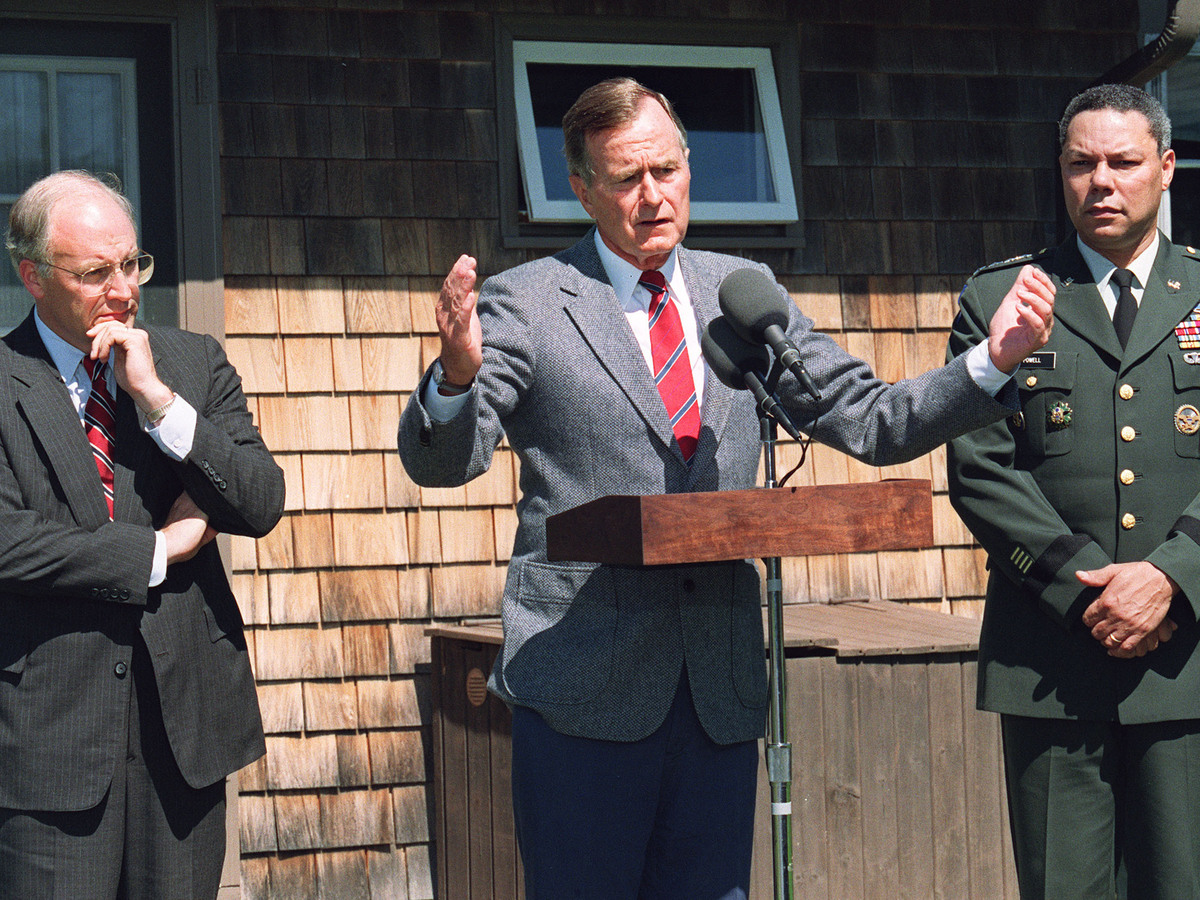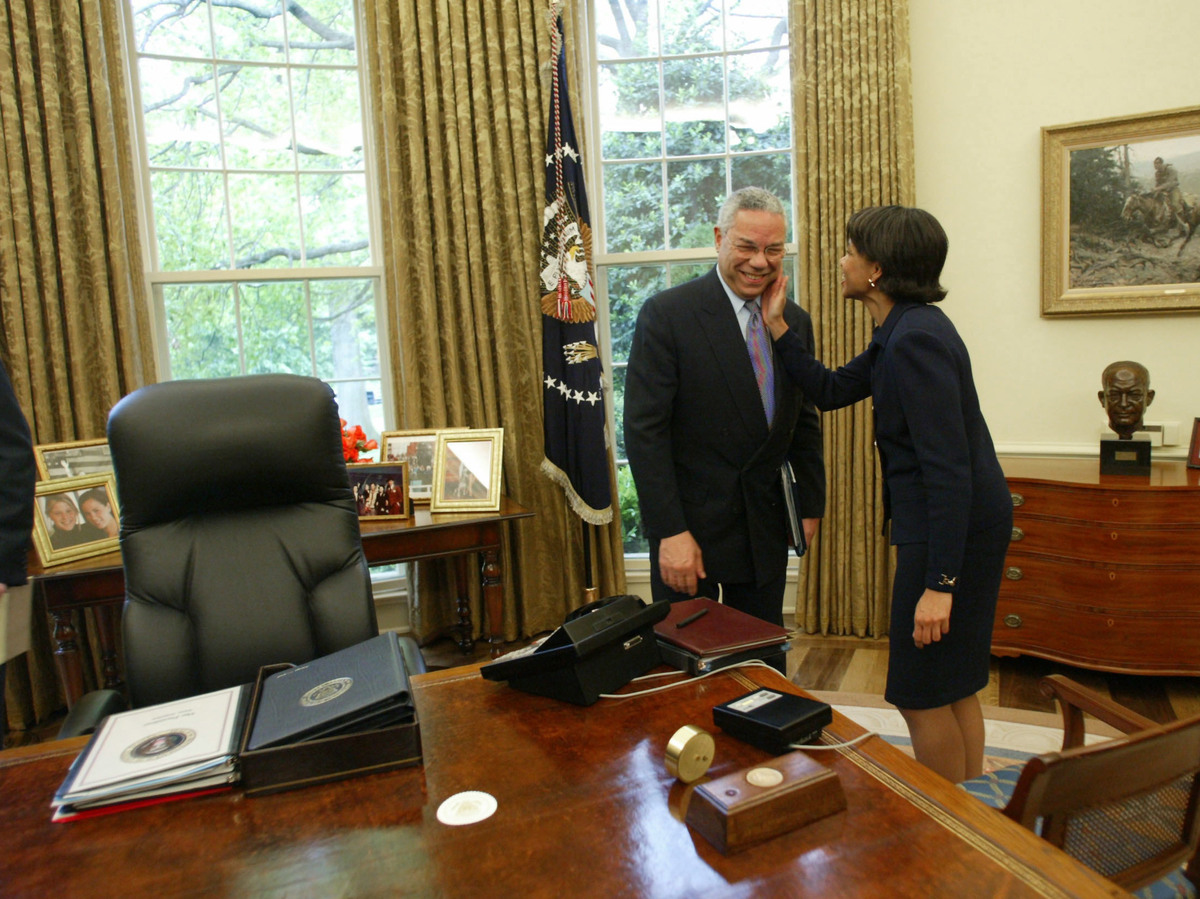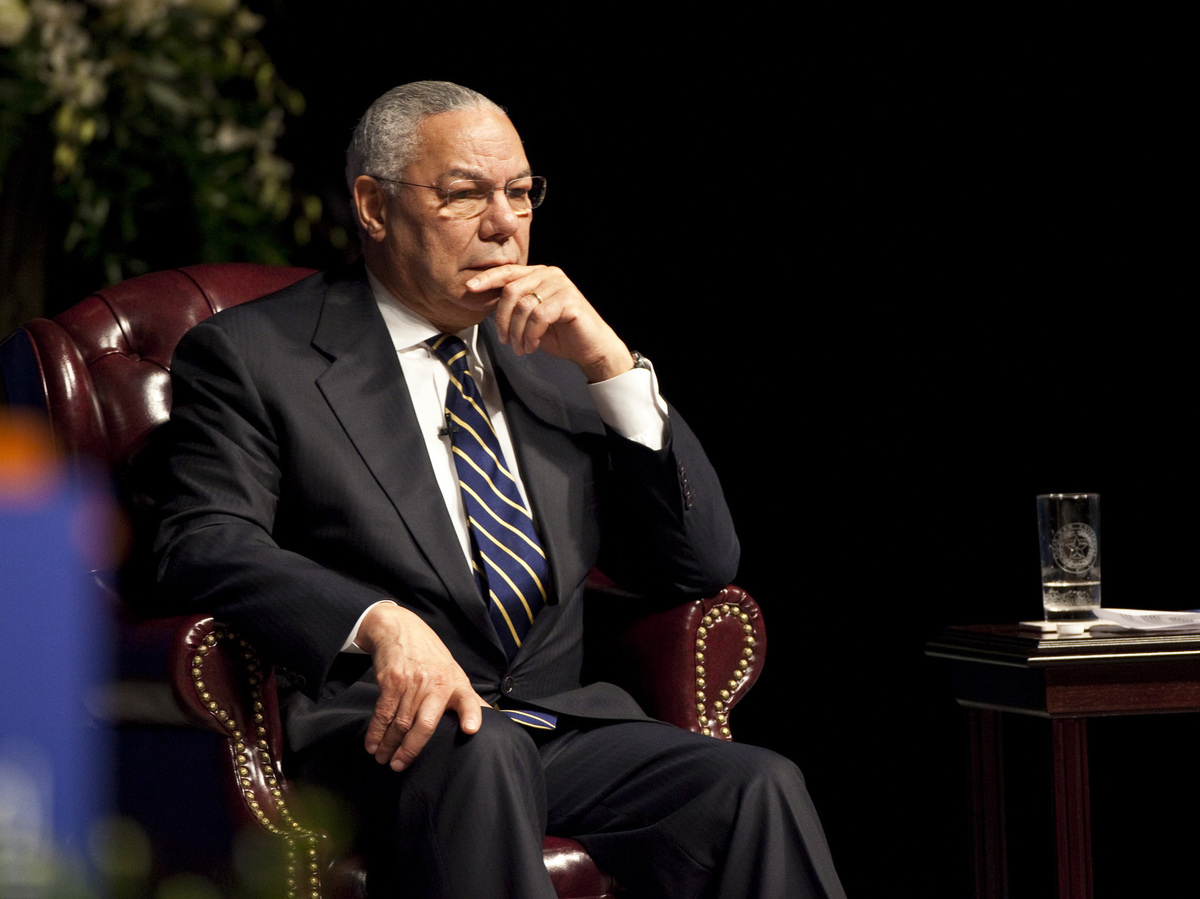
[ad_1]

President George W. Bush, with national security adviser Condoleezza Rice, Secretary of State Colin Powell and Secretary of Defense Donald Rumsfeld appear at the White House Rose Garden in June 2002. Powell’s time in the administration would be defined by the beginning of the war in Iraq.
Alex Wong/Getty Images
hide caption
toggle caption
Alex Wong/Getty Images

President George W. Bush, with national security adviser Condoleezza Rice, Secretary of State Colin Powell and Secretary of Defense Donald Rumsfeld appear at the White House Rose Garden in June 2002. Powell’s time in the administration would be defined by the beginning of the war in Iraq.
Alex Wong/Getty Images
Colin Powell has died at the age of 84 from COVID-19 complications, according to his family. He had also reportedly been treated in recent years for multiple myeloma, a blood cancer.
Powell spent much of his life in the military and served in the Reagan, George H.W. Bush and George W. Bush administrations — notably leading Operation Desert Storm in 1991 as chairman of the Joint Chiefs of Staff and serving as secretary of state from 2001 to 2005.
He was the first African American to serve in either of the two positions.

Colin Powell, chairman of the Joint Chiefs of Staff, references Iraqi troops in Kuwait during a briefing at the Pentagon on Jan. 23, 1991.
J.David Ake/AFP via Getty Images
hide caption
toggle caption
J.David Ake/AFP via Getty Images

Colin Powell, chairman of the Joint Chiefs of Staff, references Iraqi troops in Kuwait during a briefing at the Pentagon on Jan. 23, 1991.
J.David Ake/AFP via Getty Images
Powell was born in Harlem as the son of two Jamaican immigrants and was raised in the South Bronx. He attended The City College of New York and joined the Reserve Officer Training Corps (ROTC) during his time there. He received a commission as a second lieutenant after graduating in 1958, and stayed with the Army for 35 years. He rose through the ranks, becoming a 4-star general.

Gen. Colin Powell, head of the Joint Chiefs of Staff, tours the bombed courtyard of the Panamanian Defense Force Comandancia in Panama City during the U.S. invasion of Panama on Jan. 5, 1990.
Bob Pearson/AFP via Getty Images
hide caption
toggle caption
Bob Pearson/AFP via Getty Images

Gen. Colin Powell, head of the Joint Chiefs of Staff, tours the bombed courtyard of the Panamanian Defense Force Comandancia in Panama City during the U.S. invasion of Panama on Jan. 5, 1990.
Bob Pearson/AFP via Getty Images
Powell became national security adviser under President Ronald Reagan from 1987 through 1989, helping to negotiate arms treaties with the Soviet Union.

President Ronald Reagan meets with Secretary of State George Shultz, along with national security adviser Colin Powell and White House Chief of Staff Howard Baker, in the Oval Office on Feb. 19, 1988, to discuss Shultz’s trip for a series of pre-summit meetings with Kremlin leadership.
Bettmann Archive
hide caption
toggle caption
Bettmann Archive

President Ronald Reagan meets with Secretary of State George Shultz, along with national security adviser Colin Powell and White House Chief of Staff Howard Baker, in the Oval Office on Feb. 19, 1988, to discuss Shultz’s trip for a series of pre-summit meetings with Kremlin leadership.
Bettmann Archive

Newly named national security adviser Lt. Gen. Colin Powell poses with his family after his appointment to that position in November 1987.
Diana Walker/Getty Images
hide caption
toggle caption
Diana Walker/Getty Images

Newly named national security adviser Lt. Gen. Colin Powell poses with his family after his appointment to that position in November 1987.
Diana Walker/Getty Images
Powell went on to serve as chairman of the Joint Chiefs of Staff under President George H.W. Bush, leading U.S. forces in the first Gulf War against Saddam Hussein.
He developed what would be known as the “Powell Doctrine” during that time — that U.S. military action should be a last resort if there is a clear risk to national security, there should be strong public support for it and there should be an exit strategy from the conflict where there is military action.

President George H.W. Bush addresses reporters on Aug. 22, 1990, in Kennebunkport, Maine, flanked by Defense Secretary Dick Cheney (L) and Chairman of the Joint Chiefs of Staff Gen. Colin Powell, following a meeting dedicated to the military situation in the Gulf.
Jerome Delay/AFP via Getty Images
hide caption
toggle caption
Jerome Delay/AFP via Getty Images

President George H.W. Bush addresses reporters on Aug. 22, 1990, in Kennebunkport, Maine, flanked by Defense Secretary Dick Cheney (L) and Chairman of the Joint Chiefs of Staff Gen. Colin Powell, following a meeting dedicated to the military situation in the Gulf.
Jerome Delay/AFP via Getty Images
He retired from his military duties in late 1993, but would once again be present in a Republican White House when George W. Bush nominated Powell to be secretary of state.
One of his most memorable public speeches came on Feb. 5, 2003, when he gave a lengthy presentation to the United Nations detailing evidence of weapons of mass destruction said to be under the control of Saddam Hussein in Iraq.

Secretary of State Colin Powell’s presentation to the United Nations on Feb. 5, 2003 claimed that Iraq was holding stockpiles of weapons of mass destruction, which turned out not to exist.
Mario Tama/Getty Images
hide caption
toggle caption
Mario Tama/Getty Images

Secretary of State Colin Powell’s presentation to the United Nations on Feb. 5, 2003 claimed that Iraq was holding stockpiles of weapons of mass destruction, which turned out not to exist.
Mario Tama/Getty Images
As he later acknowledged, that evidence was “flawed.”

Secretary of State Colin Powell meets in the President’s Emergency Operations Center after the terrorist attacks on Sept. 11, 2001 in Washington, D.C. Powell was in Peru on the morning of the attacks.
David Bohrer/U.S. National Archives via Getty Images
hide caption
toggle caption
David Bohrer/U.S. National Archives via Getty Images

Secretary of State Colin Powell meets in the President’s Emergency Operations Center after the terrorist attacks on Sept. 11, 2001 in Washington, D.C. Powell was in Peru on the morning of the attacks.
David Bohrer/U.S. National Archives via Getty Images

Secretary of State Colin Powell gets a pat on the cheek form national security advisor Condoleezza Rice during a meeting with President George W. Bush and Israeli Prime Minister Ariel Sharon in the Oval Office at the White House on May 7, 2002.
Pool/Getty Images
hide caption
toggle caption
Pool/Getty Images

Secretary of State Colin Powell gets a pat on the cheek form national security advisor Condoleezza Rice during a meeting with President George W. Bush and Israeli Prime Minister Ariel Sharon in the Oval Office at the White House on May 7, 2002.
Pool/Getty Images
Powell left the George W. Bush administration in 2005.
Though he was a longtime Republican and had served three Republican presidents, Powell endorsed Barack Obama in the 2008 election, “because of his ability to inspire, because of the inclusive nature of his campaign, because he is reaching out all across America.” Powell again endorsed Obama in 2012.
He said he would not vote for Donald Trump in 2016 and said he voted for Joe Biden in 2020. Powell said he no longer identified with the party after the Jan. 6 riot at the U.S. Capitol.

President Barack Obama delivers remarks following a meeting with present and former national security leaders at the White House on Nov. 13, 2015. Obama met with the national security leaders on the national security implications of the Trans-Pacific Partnership trade pact. Powell was among those who attended.
Win McNamee/Getty Images
hide caption
toggle caption
Win McNamee/Getty Images

President Barack Obama delivers remarks following a meeting with present and former national security leaders at the White House on Nov. 13, 2015. Obama met with the national security leaders on the national security implications of the Trans-Pacific Partnership trade pact. Powell was among those who attended.
Win McNamee/Getty Images

Colin Powell arrives to pay his respects at the casket of the late former President George H.W. Bush at the U.S. Capitol, on Dec. 4, 2018.
Drew Angerer/Getty Images
hide caption
toggle caption
Drew Angerer/Getty Images

Colin Powell arrives to pay his respects at the casket of the late former President George H.W. Bush at the U.S. Capitol, on Dec. 4, 2018.
Drew Angerer/Getty Images
When he was asked in 2013 to reflect on his life, he said he was “blessed.”
“I’ve had the chance to serve my country, and I’ve had the chance to do things that benefited my country,” Powell said. “And when it’s all over I just hope they say he was a good soldier, he did a good job, raised a good family, and God bless him. That’s all I ask for.”

Former Chairman of the Joint Chiefs of staff and Secretary of State Colin Powell attends an event honoring the 20th anniversary of the Persian Gulf War on Jan. 20, 2011, in College Station Texas. Powell oversaw U.S. forces during that war.
Ben Sklar/Getty Images
hide caption
toggle caption
Ben Sklar/Getty Images

Former Chairman of the Joint Chiefs of staff and Secretary of State Colin Powell attends an event honoring the 20th anniversary of the Persian Gulf War on Jan. 20, 2011, in College Station Texas. Powell oversaw U.S. forces during that war.
Ben Sklar/Getty Images
[ad_2]
Source link

